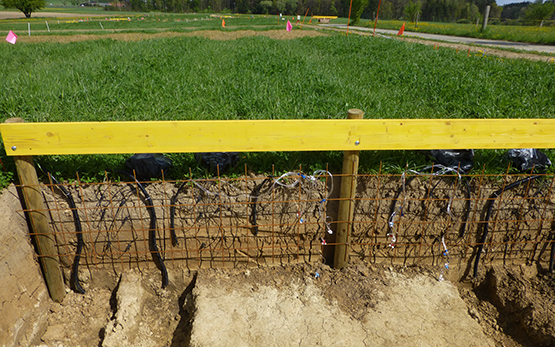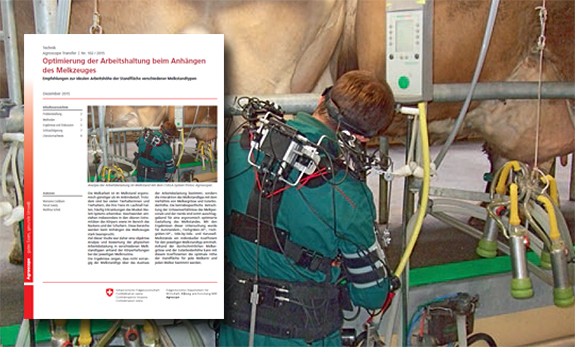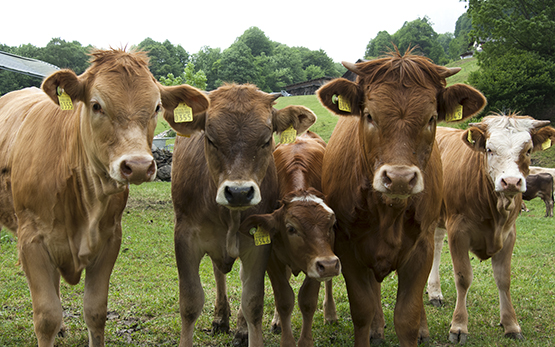Heitkämper K., Zorn A.
Arbeitszeit und Rentabilität bei PSM-Verzicht.
UFA-Revue, 6, 2024, 56-58.
weitere Sprachen: französisch
Masson S., Buchmann J., Bütler A., Cadot S., de Jong A.V., Mathys P., Rueda Ayala V. P., Seiler A., Steinger T., Vogelgsang S., Wirth J., Zorn A., Jeanneret P.
Three-year results of IPM implementation in the Swiss demonstration farms network PestiRed.
In: IPM conference. 14 May, Hrsg. INRAE, Acta, Brussels. 2024, 1.
Masson S., Buchmann J., Bütler A., Cadot S., De Jong A.V., Mathys P., Rueda Ayala V. P., Seiler A., Steinger T., Vogelgsang S., Wirth J., Zorn A., Jeanneret P.
Rendement et IFT entre parcelles innovantes et témoin.
In: Sitzung der Trägerschaft, Kommunikationsgruppe und Begleitgruppe PestiRed. 21 mars, Hrsg. IP Suisse, Zollikofen. 2024, 1.
Masson S., Wassef J., Bütler A., Cadot S., Rueda Ayala V. P., Steinger T., Vogelgsang S., Wirth J., Zorn A., Jeanneret P.
Mesures mises en oeuvre sur les parcelles PestiRed de 2020 à 2022.
In: Sitzung der Trägerschaft, Kommunikationsgruppe und Begleitgruppe PestiRed. 21 mars, Hrsg. IP Suisse, Zollikofen. 2024, 1.
Mielewczik M., Rödiger M., Zorn A., Roesch A., Heitkämper K.
Working time requirements for farm management work in organic and herbicide-reduced production of arable crops.
In: 17. Wissenschaftstagung Ökologischer Landbau. 5-8 March, Giessen. 2024, 427-428.
Rödiger M., Mielewczik M., Heitkämper K., Roesch A., Zorn A.
Auswirkungen verschiedener Pflanzenschutzstrategien auf den Arbeitszeitbedarf.
In: Tagungsband des 24. Arbeitswissenschaftlichen Kolloquiums des Fachausschusses Arbeitswissenschaften im Landbau. Hrsg. Quendler, E., Kajdy, O., Wien. 2024, 80-83.
Bütler A., Zorn A.
Lohnt sich der PSM-Verzicht in Weizen und Raps?
UFA-Revue, 11, 2023, 56-58.
weitere Sprachen: französisch
Zorn A., Bütler A., Mathys P.
Wirtschaftlichkeit des Verzichts auf Pflanzenschutzmittel bei Weizen und Raps: Ergebnisse der ersten zwei Erntejahre aus dem Projekt PestiRed.
Agroscope Science, 169, 2023, 1-31.
Fabian Y., Roberti G., Zorn A., Szerencsits E., Gramlich A.
Die Nutzung von vernässenden Ackerflächen neu denken.
Geomatik Schweiz, 121, (7-8), 2023, 161-164.
Jeanneret P., Buchmann J., Cadot S., de Jong A.-V., Seiler A., Steinger T., Vogelgsang S., Wirth J., Zorn A.
Nützlinge am Rand von Parzellen mit und ohne innovativem und agrarökologischem Ansatz.
In: Agroscope-internes Meeting PSM-Ressourcenprojekte. 24. Januar, Hrsg. Agroscope, Walierhof. 2023.
Fabian Y., Roberti G., Jacot-Ammann K., Gramlich A., Benz R., Szerencsits E., Churko G., Prasuhn V., Leifeld J., Zorn A., Walter T., Herzog F.
Ripensare l’utilizzo delle superfici coltive periodicamente inondate: Sintesi del progetto «superfici (coltive) umide».
Agroscope Science, 145, 2022, 1-18.
Roberti G., Gramlich A., Benz R., Szerencsits E., Churko G., Prasuhn V., Leifeld J., Zorn A., Jacot-Ammann K., Herzog F., Fabian Y.
Entscheidungshilfe für feuchte und nasse Ackerflächen: Unterstützung bei der Identifikation von Flächen, auf denen Alternativen zur Entwässerung in Betracht zu ziehen sind.
Agroscope Transfer, 449, 2022, 1-68.
weitere Sprachen: französisch | italienisch
Zorn A., Clémence S.
Bewertung alternativer Pflanzenschutzmassnahmen: Befragungen der Betriebe des Ressourcenprojektes PestiRed.
Agroscope Science, 141, 2022, 1-31.
weitere Sprachen: französisch
Clémence S., Dapčević Hadnađev T., Gellynck X., Haas R., Mastilović J., Meixner O., Pichlbauer M., Plzáková L., Pojić M., Šarić B., Schouteten J., Škrobot D., Van Parys E., Zagata L., Zorn A.
Value chains for new food products: CROPDIVA – D5.1.
Hrsg. CROPDIVA, Ettenhausen. 2. November, 2022, 95 S.
Fabian Y., Roberti G., Jacot-Ammann K., Gramlich A., Benz R., Szerencsits E., Churko G., Prasuhn V., Leifeld J., Zorn A., Walter T., Herzog F.
Die Nutzung von vernässenden Ackerflächen neu denken: Synthese des Projektes «Feucht(Acker)Flächen».
Agrarforschung Schweiz, 13, 2022, 198-209.
weitere Sprachen: französisch
Zorn A., Zimmert F.
Schweizer Milchviehhaltung im Wandel.
Magazin «agroscope», 6, 2022, 6-7.
weitere Sprachen: französisch | englisch
Zimmert F., Zorn A.
Direct payments and on-farm employment: Evidence from a spatial regression discontinuity design.
Q Open, In Press, 2022, 1-23.
Zorn A., Clémence S. , Buchmann J., de Jong A.-V., Masson S., Steinger T., Seiler A., Vogelgsang S., Wirth J., Jeanneret P.
Beurteilung alternativer Pflanzenschutzmassnahmen: Erste Ergebnisse aus dem Ressourcenprojekt PestiRed.
In: 45. Agrarökonomietagung. 4. Oktober, Hrsg. Agroscope, Tänikon. 2022.
Buchmann J., de Jong A.-V., Seiler A., Masson S., Zorn A., Wirth J., Steinger T., Vogelgsang S., Clémence S.
Pesticide use reduction with alternative biodiversity-friendly practices: A case study in Switzerland.
In: INTECOL2022: Frontiers in Ecology: Science & Society. 2. septembre, Geneva. 2022, 1-19.
Zorn A., Clémence S., Masson S., Jeanneret P.
PestiRed: Ein Schweizer Projekt zur Reduktion von PS-Mitteln.
Der Pflanzenarzt, (8), 2022, 6-8.








